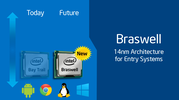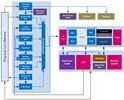Intel HD Graphics 400 (Braswell) vs Intel HD Graphics (Ivy Bridge) vs Intel HD Graphics 5300
Intel HD Graphics 400 (Braswell) ► remove from comparison
The Intel HD Graphics 400 (Braswell) is an integrated graphics card in the low end SoCs of the Braswell series (2016 Celeron models). It is based on the same architecture as the integrated GPU of the Broadwell graphics cards (e.g. HD Graphics 5300 ), but offers less shader cores and slower clock speeds.
It is a rename from the Intel HD Graphics (Braswell) card that included the faster 16 EU model in the Pentium SoCs. See the Intel HD Graphics Braswell graphics card page for benchmarks .
The performance depends on the processor (different boost speed for the GPU) and the used memory.
Gaming performance ist still only suited for older or less demanding games. Often also the processor is limited gaming performance (e.g. in the dual-core N3000).
The SoC also integrates a video decoding engine that should be able to handle 4K H.265 videos.
Intel HD Graphics (Ivy Bridge) ► remove from comparison
The Intel HD Graphics (Ivy Bridge) is an integrated graphics card in the mobile Ivy Bridge codenamed processors (Celeron and Pentium). It is the successor the the Intel HD Graphics 2000 in the Sandy Bridge CPUs and performs between the old HD 2000 and 3000 GPU .
Compared to the faster HD Graphics 4000 , the HD Graphics features less Execution Units (6 versus 16) and only one texture sampler. Therefore, the performance is clearly worse and only suited for low demanding gaming. Intel states a 10 to 15% higher performance compared to the old Sandy Bridge based HD Graphics 2000 (see our benchmarks below), which is similar to AMDs low-end GPUs like the integrated Radeon HD 8210 . Therefore, only casual games with low requirements are playable.
A speciality of the Ivy Bridge GPUs is that 4x MSAA is supported in hardware now. However, 2x is only supported through software. The algorithm to support 2x is going through the 4x pipeline with a software algorithm, so performance is similar to 4x MSAA.
The integrated video decoder called Multi Format Codec Engine (MFX) was also improved and should allow even simultaneus 4K video decoding. DXVAChecker lists MPEG2, VC1, WMV9, and H264 as supported codecs. QuickSync for fast transcoding of videos was also optimized for higher performance and better image quality.
Another new feature is the support for up to 3 independent displays (maybe only with a DisplayPort) as AMD offers with theirs Eyefinity support (up to 6 displays).
Due to the 22nm 3D Tri-Gate production process, the power consumption should be relatively low (the development was focused on performance per Watt).
Intel HD Graphics 5300 ► remove from comparison
The Intel HD Graphics 5300 (GT2) is an integrated Broadwell graphics card revealed in late 2014. It can be found in Core M ULV SoCs such as the Core M-5Y70 . While the GPU shines with its extremely low power consumption, raw performance is quite low and barely sufficient for modern games.
Architecture and Features
Broadwell features a GPU based on the Intel Gen8 architecture, which has been optimized in various aspects compared to the previous Gen7.5 (Haswell). Inter alia, the shader arrays called "subslice" have been reorganized and now offer 8 Execution Units (EUs) each. Three subslices form a "slice" for a total of 24 EUs. Combined with other improvements such as larger L1 caches and an optimized frontend, the integrated GPU has become faster and more efficient than its predecessor.
The HD Graphics 5300 represents the mid-range version of the Broadwell GPU family and consists of one slice with 24 EUs. Beyond that, there is also a low-end variant (GT1, 12 EUs) as well as higher-end models (GT3/GT3e + eDRAM, 48 EUs).
All Broadwell GPUs support OpenCL 2.0 and DirectX 11.2. The video engine can now decode H.265 using both fixed function hardware as well as available GPU shaders. Up to three displays can be connected via DP 1.2/eDP 1.3 (max. 3840 x 2160 @ 60 Hz) or HDMI 1.4a (max. 3840 x 2160 @ 24 Hz). HDMI 2.0, however, is not supported.
Performance
Depending on the specific CPU, the maximum GPU frequency varies between 800 and 900 MHz. Due to the very low TDP, however, the average clock in 3D applications will be significantly lower. Therefore, the HD 5300 just barely outperforms the old HD 4000 or HD 4200 , but requires much less energy for the same performance.
Only a few games as of 2014/2015 will run fluently at low settings, e.g. Dota 2 or Sims 4.
Power Consumption
Thanks to a new 14 nm process, the entire Core M chip is specified at just 4.5 W TDP and is suited for passively cooled tablets. The TDP is flexible and can be reduced or increased, which has a significant impact on performance.
Intel HD Graphics 400 (Braswell) Intel HD Graphics (Ivy Bridge) Intel HD Graphics 5300 HD Graphics Series Codename Braswell Ivy Bridge GT1 Broadwell GT2 Architecture Gen. 8 Gen. 7 Ivy Bridge Gen. 8 Broadwell Pipelines 12 - unified 6 - unified 24 - unified Core Speed 320 - 640 (Boost) MHz 350 - 1100 (Boost) MHz 100 - 900 (Boost) MHz Memory Bus Width 64/128 Bit 64/128 Bit 64/128 Bit Shared Memory yes yes yes API DirectX 11.2, Shader 5.0 DirectX 11.0, Shader 5.0 DirectX 12 (FL 11_1), OpenGL 4.3 technology 14 nm 22 nm 14 nm Date of Announcement 01.04.2016 01.10.2012 05.09.2014 Transistors 1.3 Billion Features QuickSync
CPU in HD Graphics 400 (Braswell) GPU Base Speed GPU Boost / Turbo Intel Atom x5-Z8550 4 x 1440 MHz 200 MHz 600 MHz Intel Celeron N3060 2 x 1600 MHz, 6 W 320 MHz 700 MHz min. - max. 200 - 320 MHz 600 - 700 MHz
CPU in HD Graphics (Ivy Bridge) GPU Base Speed GPU Boost / Turbo Intel Pentium 2030M 2 x 2500 MHz, 35 W 650 MHz 1100 MHz Intel Pentium 2020M 2 x 2400 MHz, 35 W 650 MHz 1100 MHz Intel Celeron 1020E 2 x 2200 MHz, 35 W 650 MHz 1000 MHz » show 12 more Intel Celeron 1020M 2 x 2100 MHz, 35 W 650 MHz 1000 MHz Intel Pentium 2127U 2 x 1900 MHz, 17 W 350 MHz 1100 MHz Intel Celeron 1005M 2 x 1900 MHz, 35 W 650 MHz 1000 MHz Intel Pentium 2117U 2 x 1800 MHz, 17 W 350 MHz 1000 MHz Intel Celeron 1000M 2 x 1800 MHz, 35 W 650 MHz 1000 MHz Intel Celeron 1037U 2 x 1800 MHz, 17 W 350 MHz 1000 MHz Intel Celeron 1017U 2 x 1600 MHz, 17 W 350 MHz 1000 MHz Intel Celeron 1007U 2 x 1500 MHz, 17 W 350 MHz 1000 MHz Intel Celeron 1047UE 2 x 1400 MHz, 17 W 350 MHz 900 MHz Intel Pentium 2129Y 2 x 1100 MHz, 10 W 350 MHz 850 MHz Intel Celeron 1019Y 2 x 1000 MHz, 10 W 350 MHz 800 MHz Intel Celeron 927UE 1 x 1500 MHz, 17 W 350 MHz 900 MHz min. - max. 200 - 650 MHz 600 - 1100 MHz
CPU in HD Graphics 5300 GPU Base Speed GPU Boost / Turbo Intel Core M-5Y71 2 x 1200 MHz, 4.5 W 300 MHz 900 MHz Intel Core M-5Y51 2 x 1100 MHz, 4.5 W 300 MHz 900 MHz Intel Core M-5Y70 2 x 1100 MHz, 4.5 W 100 MHz 850 MHz » show 4 more Intel Core M-5Y31 2 x 900 MHz, 4.5 W 300 MHz 850 MHz Intel Core M-5Y10c 2 x 800 MHz, 4.5 W 300 MHz 800 MHz Intel Core M-5Y10a 2 x 800 MHz, 4.5 W 100 MHz 800 MHz Intel Core M-5Y10 2 x 800 MHz, 4.5 W 100 MHz 800 MHz min. - max. 100 - 650 MHz 600 - 1100 MHz
Benchmarks Performance Rating - 3DMark 11 + Fire Strike + Time Spy - HD Graphics 400 (Braswell)
0.1 pt (0%)
Intel HD Graphics 400 (Braswell)
...
max:
Performance Rating - 3DMark 11 + Fire Strike + Time Spy - HD Graphics (Ivy Bridge)
0.1 pt (0%)
...
Intel HD Graphics (Ivy Bridge)
...
max:
Performance Rating - 3DMark 11 + Fire Strike + Time Spy - HD Graphics 5300
0.2 pt (1%)
...
...
max:
3DMark - 3DMark Ice Storm Unlimited Graphics
min: 17968 avg: 20459 median: 20277 (2%) max: 23161 Points
min: 39138 avg: 55907 median: 59555 (7%) max: 65380 Points
3DMark - 3DMark Ice Storm Extreme Graphics
14334 Points (2%)
min: 19630 avg: 24597 median: 24597 (3%) max: 29564 Points
3DMark - 3DMark Cloud Gate Score
min: 1350 avg: 1553 median: 1457 (2%) max: 2087 Points
min: 1478 avg: 1898 median: 1906.5 (2%) max: 2207 Points
min: 1361 avg: 3085 median: 3041 (3%) max: 4274 Points
3DMark - 3DMark Cloud Gate Graphics
min: 1519 avg: 1865 median: 1841 (0%) max: 2455 Points
min: 2116 avg: 2283 median: 2286 (1%) max: 2470 Points
min: 2895 avg: 3862 median: 3720 (1%) max: 5512 Points
3DMark - 3DMark Fire Strike Standard Score
min: 176 avg: 188 median: 188 (0%) max: 200 Points
min: 208 avg: 253.6 median: 254.5 (0%) max: 275 Points
min: 327 avg: 413.8 median: 407 (1%) max: 620 Points
3DMark - 3DMark Fire Strike Standard Graphics
min: 202 avg: 218 median: 218 (0%) max: 234 Points
min: 248 avg: 286.2 median: 285.5 (0%) max: 305 Points
min: 352 avg: 453.8 median: 439 (0%) max: 671 Points
3DMark - 3DMark Ice Storm Graphics
min: 13689 avg: 18517 median: 18516.5 (2%) max: 23344 Points
min: 22834 avg: 24734 median: 24209.5 (3%) max: 29149 Points
min: 27164 avg: 35716 median: 34405 (4%) max: 48901 Points
3DMark - 3DMark Sling Shot (ES 3.0) Unlimited
min: 1502 avg: 1926 median: 1925.5 (8%) max: 2349 Points
3DMark - 3DMark Sling Shot (ES 3.0) Unlimited Graphics
min: 1452 avg: 2046 median: 2046 (4%) max: 2640 Points
3DMark - 3DMark Sling Shot Extreme (ES 3.1) Unlimited
1180 Points (6%)
3DMark - 3DMark Sling Shot Extreme (ES 3.1) Unlimited Graphics
977 Points (3%)
3DMark 11 - 3DM11 Performance Score
min: 289 avg: 386.1 median: 397 (1%) max: 478 Points
min: 258 avg: 363.3 median: 370.5 (1%) max: 413 Points
min: 498 avg: 721 median: 731 (1%) max: 973 Points
3DMark 11 - 3DM11 Performance GPU
min: 247 avg: 341.1 median: 349 (0%) max: 418 Points
min: 218 avg: 310.6 median: 315 (0%) max: 352 Points
min: 458 avg: 648 median: 647 (1%) max: 885 Points
3DMark Vantage + Intel HD Graphics (Ivy Bridge) 3DMark Vantage - 3DM Vant. Perf. total
min: 930 avg: 1465 median: 1491 (0%) max: 1691 Points
3DM Vant. Perf. total + Intel HD Graphics 5300
min: 2966 avg: 3104 median: 3104 (1%) max: 3242 Points
3DM Vant. Perf. GPU no PhysX + Intel HD Graphics (Ivy Bridge) 3DMark Vantage - 3DM Vant. Perf. GPU no PhysX
min: 728 avg: 1186 median: 1213 (1%) max: 1360 Points
3DM Vant. Perf. GPU no PhysX + Intel HD Graphics 5300
min: 2538 avg: 2914 median: 2913.5 (2%) max: 3289 Points
3DMark 2001SE - 3DMark 2001 - Standard
min: 8075 avg: 9212 median: 9212 (10%) max: 10349 Points
3DMark 03 - 3DMark 03 - Standard
min: 5909 avg: 7584 median: 7434 (4%) max: 10124 Points
3DMark 05 - 3DMark 05 - Standard
min: 3839 avg: 5085 median: 5186 (6%) max: 6252 Points
3DMark 06 3DMark 06 - Standard 1280x1024 + Intel HD Graphics 400 (Braswell)
2474 Points (3%)
3DMark 06 - Standard 1280x1024 + Intel HD Graphics (Ivy Bridge)
min: 2186 avg: 2949 median: 2930 (4%) max: 3573 Points
3DMark 06 - Standard 1280x1024 + Intel HD Graphics 5300
min: 3951 avg: 5044 median: 4775 (6%) max: 6754 Points
Unigine Heaven 3.0 - Unigine Heaven 3.0 DX 11
7.6 fps (3%)
SPECviewperf 11 + Intel HD Graphics (Ivy Bridge) SPECviewperf 11 - specvp11 snx-01
min: 0.75 avg: 0.8 median: 0.8 (0%) max: 0.87 fps
specvp11 tcvis-02 + Intel HD Graphics (Ivy Bridge) SPECviewperf 11 - specvp11 tcvis-02
min: 1.31 avg: 1.5 median: 1.5 (1%) max: 1.66 fps
specvp11 sw-02 + Intel HD Graphics (Ivy Bridge) SPECviewperf 11 - specvp11 sw-02
min: 4.68 avg: 5.3 median: 5.3 (4%) max: 5.88 fps
specvp11 proe-05 + Intel HD Graphics (Ivy Bridge) SPECviewperf 11 - specvp11 proe-05
min: 0.91 avg: 1.1 median: 1.1 (1%) max: 1.19 fps
specvp11 maya-03 + Intel HD Graphics (Ivy Bridge) SPECviewperf 11 - specvp11 maya-03
min: 8.71 avg: 8.8 median: 8.8 (7%) max: 8.93 fps
specvp11 lightwave-01 + Intel HD Graphics (Ivy Bridge) SPECviewperf 11 - specvp11 lightwave-01
min: 7.83 avg: 8.9 median: 8.9 (10%) max: 10.03 fps
specvp11 ensight-04 + Intel HD Graphics (Ivy Bridge) SPECviewperf 11 - specvp11 ensight-04
min: 1.27 avg: 1.4 median: 1.4 (1%) max: 1.51 fps
specvp11 catia-03 + Intel HD Graphics (Ivy Bridge) SPECviewperf 11 - specvp11 catia-03
0 fps (0%)
SPECviewperf 12 + Intel HD Graphics 5300 SPECviewperf 12 - specvp12 sw-03
min: 0.97 avg: 4.7 median: 4.7 (1%) max: 8.44 fps
specvp12 snx-02 + Intel HD Graphics 5300 SPECviewperf 12 - specvp12 snx-02
min: 1.07 avg: 1.2 median: 1.2 (0%) max: 1.28 fps
specvp12 showcase-01 + Intel HD Graphics 5300 SPECviewperf 12 - specvp12 showcase-01
min: 2.69 avg: 4.7 median: 4.7 (1%) max: 6.69 fps
specvp12 mediacal-01 + Intel HD Graphics 5300 SPECviewperf 12 - specvp12 mediacal-01
min: 0.58 avg: 0.8 median: 0.8 (0%) max: 1.1 fps
specvp12 maya-04 + Intel HD Graphics 5300 SPECviewperf 12 - specvp12 maya-04
min: 2.13 avg: 4 median: 4 (1%) max: 5.79 fps
specvp12 energy-01 + Intel HD Graphics 5300 SPECviewperf 12 - specvp12 energy-01
min: 0.04 avg: 4.5 median: 4.5 (4%) max: 9 fps
specvp12 creo-01 + Intel HD Graphics 5300 SPECviewperf 12 - specvp12 creo-01
min: 0.91 avg: 2.8 median: 2.8 (1%) max: 4.73 fps
specvp12 catia-04 + Intel HD Graphics 5300 SPECviewperf 12 - specvp12 catia-04
5.5 fps (1%)
Windows 7 Experience Index - Win7 Gaming graphics
6.2 Points (78%)
Windows 7 Experience Index - Win7 Graphics
min: 4.6 avg: 4.7 median: 4.7 (59%) max: 4.7 Points
Cinebench R10 Cinebench R10 Shading (32bit) + Intel HD Graphics 400 (Braswell) Cinebench R10 - Cinebench R10 Shading (32bit)
min: 1627 avg: 2057 median: 2052.5 (1%) max: 2510 Points
Cinebench R10 Shading (32bit) + Intel HD Graphics (Ivy Bridge)
min: 2410 avg: 3337 median: 3382 (2%) max: 4037 Points
Cinebench R10 Shading (32bit) + Intel HD Graphics 5300
min: 2978 avg: 4412 median: 4018 (3%) max: 6679 Points
Cinebench R11.5 Cinebench R11.5 OpenGL 64 Bit + Intel HD Graphics 400 (Braswell) Cinebench R11.5 - Cinebench R11.5 OpenGL 64 Bit
min: 9.97 avg: 10.1 median: 10 (3%) max: 10.12 fps
Cinebench R11.5 OpenGL 64 Bit + Intel HD Graphics (Ivy Bridge)
min: 6.62 avg: 9.1 median: 9.2 (3%) max: 11.32 fps
Cinebench R11.5 OpenGL 64 Bit + Intel HD Graphics 5300
min: 11.6 avg: 16.4 median: 15.9 (6%) max: 23.2 fps
Cinebench R15 + Intel HD Graphics 400 (Braswell) Cinebench R15 - Cinebench R15 OpenGL 64 Bit
min: 8.48 avg: 11 median: 11.3 (1%) max: 13.98 fps
Cinebench R15 OpenGL 64 Bit + Intel HD Graphics 5300
min: 16.04 avg: 19 median: 18.4 (1%) max: 23.64 fps
Cinebench R15 OpenGL Ref. Match 64 Bit + Intel HD Graphics 400 (Braswell) Cinebench R15 - Cinebench R15 OpenGL Ref. Match 64 Bit
98 % (98%)
Cinebench R15 OpenGL Ref. Match 64 Bit + Intel HD Graphics 5300
min: 98 avg: 98.1 median: 98 (98%) max: 99.3 %
GFXBench - GFXBench 5.0 Aztec Ruins High Tier Offscreen
3.3 fps (1%)
GFXBench - GFXBench 5.0 Aztec Ruins Normal Tier Offscreen
9.3 fps (1%)
GFXBench 3.1 - GFXBench Manhattan ES 3.1 Offscreen
min: 7.2 avg: 10.6 median: 10.6 (0%) max: 14 fps
GFXBench 3.0 - GFXBench 3.0 Manhattan Offscreen
min: 14 avg: 16 median: 16 (1%) max: 18 fps
min: 26.7 avg: 30.3 median: 30.1 (2%) max: 34.1 fps
GFXBench (DX / GLBenchmark) 2.7 + Intel HD Graphics 400 (Braswell) GFXBench (DX / GLBenchmark) 2.7 - GFXBench T-Rex HD Offscreen C24Z16
min: 27 avg: 29 median: 29 (0%) max: 31 fps
GFXBench T-Rex HD Offscreen C24Z16 + Intel HD Graphics (Ivy Bridge) 27 fps (0%)
GFXBench T-Rex HD Offscreen C24Z16 + Intel HD Graphics 5300
min: 39.4 avg: 54.4 median: 55 (0%) max: 66.2 fps
LuxMark v2.0 64Bit - LuxMark v2.0 Room GPU
min: 27 avg: 38.3 median: 44 (0%) max: 44 Samples/s
min: 93 avg: 116.7 median: 112 (1%) max: 145 Samples/s
LuxMark v2.0 64Bit - LuxMark v2.0 Sala GPU
44 Samples/s (0%)
min: 180 avg: 228.7 median: 210 (0%) max: 296 Samples/s
ComputeMark v2.1 - ComputeMark v2.1 Result
min: 190 avg: 266.4 median: 275 (0%) max: 290 Points
min: 460 avg: 519 median: 518.5 (1%) max: 577 Points
Average Benchmarks Intel HD Graphics 400 (Braswell) → 100% n=11 Average Benchmarks Intel HD Graphics (Ivy Bridge) → 119% n=11 Average Benchmarks Intel HD Graphics 5300 → 193% n=11
- Range of benchmark values for this graphics card
- Average benchmark values for this graphics card
* Smaller numbers mean a higher performance
1 This benchmark is not used for the average calculation
Game Benchmarks The following benchmarks stem from our benchmarks of review laptops. The performance depends on the used graphics memory, clock rate, processor, system settings, drivers, and operating systems. So the results don't have to be representative for all laptops with this GPU. For detailed information on the benchmark results, click on the fps number.
100%
HD Graphics 400 (Braswell):
14.1 fps
100%
HD Graphics 400 (Braswell):
18.5 fps
100%
HD Graphics 400 (Braswell):
16 fps
100%
HD Graphics 400 (Braswell):
12.7 fps
100%
HD Graphics 400 (Braswell):
6.8 fps
100%
HD Graphics 400 (Braswell):
10.7 fps
100%
HD Graphics 400 (Braswell):
20.9 fps
100%
HD Graphics 400 (Braswell):
5.8 fps
100%
HD Graphics 400 (Braswell):
9.7 fps
HD Graphics 5300:
12.2 fps
100%
HD Graphics 400 (Braswell):
15 15.1 ~ 15 fps
100%
HD Graphics 400 (Braswell):
9.5 9.7 ~ 10 fps
HD Graphics 5300:
10.8 fps
100%
HD Graphics 400 (Braswell):
5.3 fps
125%
HD Graphics 5300:
6.6 fps
100%
HD Graphics 400 (Braswell):
7.3 fps
181%
HD Graphics 5300:
13.2 fps
100%
HD Graphics 400 (Braswell):
3.2 fps
266%
HD Graphics 5300:
8.5 fps
HD Graphics 5300:
13.8 fps
HD Graphics 5300:
10.6 fps
100%
HD Graphics 400 (Braswell):
36.5 fps
72%
HD Graphics 5300:
26.3 fps
100%
HD Graphics 400 (Braswell):
14.2 fps
108%
HD Graphics 5300:
15.3 fps
100%
HD Graphics 400 (Braswell):
9 fps
100%
HD Graphics 400 (Braswell):
13 fps
200%
HD Graphics 5300:
26 fps
100%
HD Graphics 400 (Braswell):
8 fps
221%
HD Graphics 5300:
17.7 fps
100%
HD Graphics 400 (Braswell):
13.3 fps
155%
HD Graphics 5300:
20.6 fps
HD Graphics 5300:
12.4 fps
100%
HD Graphics 400 (Braswell):
21.3 fps
100%
HD Graphics 400 (Braswell):
11.4 fps
100%
HD Graphics 400 (Braswell):
8.5 fps
73%
HD Graphics 5300:
6.2 fps
100%
HD Graphics 400 (Braswell):
5.6 fps
66%
HD Graphics 5300:
3.7 fps
100%
HD Graphics 400 (Braswell):
40.1 fps
102%
HD Graphics 5300:
41 fps
100%
HD Graphics 400 (Braswell):
11.7 fps
107%
HD Graphics 5300:
12.5 fps
100%
HD Graphics 400 (Braswell):
14.3 fps
HD Graphics 5300:
15.3 fps
100%
HD Graphics 400 (Braswell):
5.4 fps
204%
HD Graphics 5300:
11 11.9 ~ 11 fps
100%
HD Graphics 400 (Braswell):
2.9 fps
276%
HD Graphics 5300:
7.6 8.2 ~ 8 fps
HD Graphics 5300:
3 3.1 ~ 3 fps
HD Graphics 5300:
21.2 fps
100%
HD Graphics 400 (Braswell):
27 fps
130%
HD Graphics 5300:
33 34 39 ~ 35 fps
100%
HD Graphics 400 (Braswell):
16 fps
138%
HD Graphics 5300:
20 20 25 ~ 22 fps
HD Graphics 5300:
12 13 14 ~ 13 fps
100%
HD Graphics 400 (Braswell):
11.5 11.9 ~ 12 fps
100%
HD Graphics 400 (Braswell):
7 fps
100%
HD Graphics 400 (Braswell):
37 fps
246%
HD Graphics 5300:
91 fps
100%
HD Graphics 400 (Braswell):
7.6 fps
232%
HD Graphics 5300:
17.6 fps
100%
HD Graphics 400 (Braswell):
6.5 fps
266%
HD Graphics 5300:
17.3 fps
100%
HD Graphics 400 (Braswell):
4.8 fps
244%
HD Graphics 5300:
11.7 fps
100%
HD Graphics 400 (Braswell):
28.9 fps
100%
HD Graphics 400 (Braswell):
12.5 fps
HD Graphics 5300:
12.5 fps
HD Graphics 5300:
18.3 fps
HD Graphics 5300:
11.1 fps
HD Graphics (Ivy Bridge):
34.5 fps
HD Graphics (Ivy Bridge):
14.3 fps
HD Graphics (Ivy Bridge):
8.6 fps
HD Graphics (Ivy Bridge):
5.9 fps
HD Graphics 5300:
8.3 [X] HP Elitebook Folio 1020 G1 H9V72EA Intel Core M-5Y51 1.1GHz
HD Graphics 5300
9.3 9.5 10.8 ~ 9 fps
HD Graphics (Ivy Bridge):
3.6 fps
HD Graphics 5300:
5.1 5.3 5.5 [X] HP Elitebook Folio 1020 G1 H9V72EA Intel Core M-5Y51 1.1GHz
HD Graphics 5300
6.9 ~ 6 fps
HD Graphics 5300:
4.3 4.3 4.4 4.6 [X] HP Elitebook Folio 1020 G1 H9V72EA Intel Core M-5Y51 1.1GHz
HD Graphics 5300
~ 4 fps
HD Graphics 5300:
2 [X] HP Elitebook Folio 1020 G1 H9V72EA Intel Core M-5Y51 1.1GHz
HD Graphics 5300
2.2 ~ 2 fps
100%
HD Graphics 400 (Braswell):
11.8 fps
127%
HD Graphics (Ivy Bridge):
15 fps
226%
HD Graphics 5300:
26.7 fps
HD Graphics (Ivy Bridge):
7.6 fps
HD Graphics 5300:
10.7 fps
100%
HD Graphics 400 (Braswell):
16.2 fps
94%
HD Graphics 5300:
15.2 fps
100%
HD Graphics 400 (Braswell):
12.3 fps
94%
HD Graphics 5300:
11.6 fps
100%
HD Graphics 400 (Braswell):
7.9 fps
95%
HD Graphics 5300:
7.5 fps
100%
HD Graphics 400 (Braswell):
30 fps
100%
HD Graphics 400 (Braswell):
28 fps
71%
HD Graphics (Ivy Bridge):
20 fps
100%
HD Graphics 400 (Braswell):
17 fps
82%
HD Graphics (Ivy Bridge):
14 fps
HD Graphics 5300:
91.4 fps
HD Graphics (Ivy Bridge):
54.4 fps
HD Graphics 5300:
48.8 fps
HD Graphics (Ivy Bridge):
32 fps
HD Graphics 5300:
45.2 fps
HD Graphics 5300:
21.6 fps
HD Graphics 5300:
24.9 fps
HD Graphics 5300:
17.4 fps
HD Graphics 5300:
18.2 fps
HD Graphics 5300:
11.7 fps
100%
HD Graphics 400 (Braswell):
30 fps
100%
HD Graphics 400 (Braswell):
30 fps
HD Graphics (Ivy Bridge):
18.4 30.5 ~ 24 fps
HD Graphics 5300:
33.1 48 50.9 51.2 [X] HP Elitebook Folio 1020 G1 H9V72EA Intel Core M-5Y51 1.1GHz
HD Graphics 5300
53.6 ~ 47 fps
HD Graphics (Ivy Bridge):
8.2 24.5 ~ 16 fps
HD Graphics 5300:
21.4 23.2 26.7 28.6 29.7 [X] HP Elitebook Folio 1020 G1 H9V72EA Intel Core M-5Y51 1.1GHz
HD Graphics 5300
~ 26 fps
HD Graphics 5300:
9.8 12.2 14.9 15.4 [X] HP Elitebook Folio 1020 G1 H9V72EA Intel Core M-5Y51 1.1GHz
HD Graphics 5300
~ 13 fps
100%
HD Graphics 400 (Braswell):
19.9 fps
138%
HD Graphics (Ivy Bridge):
27.5 fps
206%
HD Graphics 5300:
41 fps
100%
HD Graphics 400 (Braswell):
12.5 fps
103%
HD Graphics (Ivy Bridge):
12.8 fps
171%
HD Graphics 5300:
21.3 fps
HD Graphics (Ivy Bridge):
12.5 fps
HD Graphics (Ivy Bridge):
10.5 fps
HD Graphics 5300:
13.3 fps
HD Graphics (Ivy Bridge):
8.1 fps
HD Graphics 5300:
10.1 fps
HD Graphics (Ivy Bridge):
4.4 fps
94%
HD Graphics (Ivy Bridge):
16 16.4 19.1 ~ 17 fps
100%
HD Graphics (Ivy Bridge):
8.6 8.9 9 ~ 9 fps
100%
HD Graphics 400 (Braswell):
6.2 fps
124%
HD Graphics (Ivy Bridge):
7.7 fps
100%
HD Graphics 400 (Braswell):
1.8 fps
HD Graphics (Ivy Bridge):
80.8 112 [X] Medion Akoya E7221-MD98297 Intel Pentium 2020M 2.4GHz
HD Graphics (Ivy Bridge)
~ 96 fps
HD Graphics (Ivy Bridge):
19.3 24 [X] Medion Akoya E7221-MD98297 Intel Pentium 2020M 2.4GHz
HD Graphics (Ivy Bridge)
~ 22 fps
HD Graphics (Ivy Bridge):
10.8 15 [X] Medion Akoya E7221-MD98297 Intel Pentium 2020M 2.4GHz
HD Graphics (Ivy Bridge)
~ 13 fps
HD Graphics 5300:
18 20.5 ~ 19 fps
HD Graphics (Ivy Bridge):
4 [X] Medion Akoya E7221-MD98297 Intel Pentium 2020M 2.4GHz
HD Graphics (Ivy Bridge)
fps
HD Graphics 5300:
12.4 fps
100%
HD Graphics 400 (Braswell):
24.8 fps
100%
HD Graphics 400 (Braswell):
10.2 (!) fps
HD Graphics (Ivy Bridge):
5.1 7.4 7.6 8 [X] Medion Akoya E7221-MD98297 Intel Pentium 2020M 2.4GHz
HD Graphics (Ivy Bridge)
~ 7 fps
HD Graphics 5300:
12.5 fps
100%
HD Graphics 400 (Braswell):
21.1 fps
199%
HD Graphics (Ivy Bridge):
42 [X] Medion Akoya E7221-MD98297 Intel Pentium 2020M 2.4GHz
HD Graphics (Ivy Bridge)
fps
170%
HD Graphics 5300:
35.9 fps
100%
HD Graphics 400 (Braswell):
10.8 fps
157%
HD Graphics (Ivy Bridge):
17 [X] Medion Akoya E7221-MD98297 Intel Pentium 2020M 2.4GHz
HD Graphics (Ivy Bridge)
fps
169%
HD Graphics 5300:
18.3 fps
100%
HD Graphics 400 (Braswell):
8.7 fps
138%
HD Graphics (Ivy Bridge):
12 [X] Medion Akoya E7221-MD98297 Intel Pentium 2020M 2.4GHz
HD Graphics (Ivy Bridge)
fps
160%
HD Graphics 5300:
13.9 fps
HD Graphics (Ivy Bridge):
6 [X] Medion Akoya E7221-MD98297 Intel Pentium 2020M 2.4GHz
HD Graphics (Ivy Bridge)
fps
HD Graphics 5300:
19.4 fps
HD Graphics 5300:
12.6 fps
HD Graphics (Ivy Bridge):
13 [X] Medion Akoya E7221-MD98297 Intel Pentium 2020M 2.4GHz
HD Graphics (Ivy Bridge)
fps
HD Graphics (Ivy Bridge):
11 [X] Medion Akoya E7221-MD98297 Intel Pentium 2020M 2.4GHz
HD Graphics (Ivy Bridge)
fps
HD Graphics (Ivy Bridge):
4 [X] Medion Akoya E7221-MD98297 Intel Pentium 2020M 2.4GHz
HD Graphics (Ivy Bridge)
fps
HD Graphics 5300:
11.8 fps
HD Graphics (Ivy Bridge):
18 19 ~ 19 fps
HD Graphics (Ivy Bridge):
14 15.2 ~ 15 fps
HD Graphics (Ivy Bridge):
18.3 52 69.7 90 [X] Medion Akoya E7221-MD98297 Intel Pentium 2020M 2.4GHz
HD Graphics (Ivy Bridge)
~ 58 fps
HD Graphics (Ivy Bridge):
13.2 32.8 42.7 54 [X] Medion Akoya E7221-MD98297 Intel Pentium 2020M 2.4GHz
HD Graphics (Ivy Bridge)
~ 36 fps
HD Graphics (Ivy Bridge):
8.6 20.9 23 29 [X] Medion Akoya E7221-MD98297 Intel Pentium 2020M 2.4GHz
HD Graphics (Ivy Bridge)
~ 20 fps
HD Graphics (Ivy Bridge):
13 [X] Medion Akoya E7221-MD98297 Intel Pentium 2020M 2.4GHz
HD Graphics (Ivy Bridge)
fps
HD Graphics (Ivy Bridge):
20 25 [X] Medion Akoya E7221-MD98297 Intel Pentium 2020M 2.4GHz
HD Graphics (Ivy Bridge)
~ 23 fps
HD Graphics (Ivy Bridge):
18 20 [X] Medion Akoya E7221-MD98297 Intel Pentium 2020M 2.4GHz
HD Graphics (Ivy Bridge)
~ 19 fps
HD Graphics (Ivy Bridge):
16 [X] Medion Akoya E7221-MD98297 Intel Pentium 2020M 2.4GHz
HD Graphics (Ivy Bridge)
16 ~ 16 fps
HD Graphics (Ivy Bridge):
12 [X] Medion Akoya E7221-MD98297 Intel Pentium 2020M 2.4GHz
HD Graphics (Ivy Bridge)
fps
HD Graphics 5300:
20.2 fps
HD Graphics 5300:
11.3 fps
HD Graphics (Ivy Bridge):
30 [X] Medion Akoya E7221-MD98297 Intel Pentium 2020M 2.4GHz
HD Graphics (Ivy Bridge)
fps
HD Graphics 5300:
46.6 fps
HD Graphics (Ivy Bridge):
8 [X] Medion Akoya E7221-MD98297 Intel Pentium 2020M 2.4GHz
HD Graphics (Ivy Bridge)
fps
HD Graphics 5300:
12.9 fps
HD Graphics (Ivy Bridge):
5 [X] Medion Akoya E7221-MD98297 Intel Pentium 2020M 2.4GHz
HD Graphics (Ivy Bridge)
fps
100%
HD Graphics 400 (Braswell):
10.5 fps
600%
HD Graphics 5300:
53.5 62 73 ~ 63 fps
HD Graphics (Ivy Bridge):
37 [X] Medion Akoya E7221-MD98297 Intel Pentium 2020M 2.4GHz
HD Graphics (Ivy Bridge)
fps
HD Graphics (Ivy Bridge):
20 [X] Medion Akoya E7221-MD98297 Intel Pentium 2020M 2.4GHz
HD Graphics (Ivy Bridge)
fps
HD Graphics (Ivy Bridge):
11 [X] Medion Akoya E7221-MD98297 Intel Pentium 2020M 2.4GHz
HD Graphics (Ivy Bridge)
fps
HD Graphics 5300:
14.1 17 ~ 16 fps
HD Graphics 5300:
7.1 7.2 ~ 7 fps
HD Graphics (Ivy Bridge):
33.3 [X] Wortmann Terra Mobile 1512 Intel Celeron 1037U 1.8GHz
HD Graphics (Ivy Bridge)
38 ~ 36 fps
HD Graphics (Ivy Bridge):
13.2 [X] Wortmann Terra Mobile 1512 Intel Celeron 1037U 1.8GHz
HD Graphics (Ivy Bridge)
13.5 ~ 13 fps
100%
HD Graphics 400 (Braswell):
18.3 fps
160%
HD Graphics (Ivy Bridge):
29.2 fps
HD Graphics (Ivy Bridge):
17.5 fps
HD Graphics (Ivy Bridge):
14.6 fps
HD Graphics 5300:
10.6 20 ~ 15 fps
HD Graphics 5300:
11.2 fps
100%
HD Graphics 400 (Braswell):
27.7 fps
94%
HD Graphics (Ivy Bridge):
11.1 23.1 26 26.5 27.6 27.8 28.4 28.5 [X] Wortmann Terra Mobile 1512 Intel Celeron 1037U 1.8GHz
HD Graphics (Ivy Bridge)
37.1 [X] Lenovo B590 (59-362559) Intel Pentium 2020M 2.4GHz
HD Graphics (Ivy Bridge)
~ 26 fps
155%
HD Graphics 5300:
40.5 45 ~ 43 fps
HD Graphics (Ivy Bridge):
5.5 11.2 11.4 11.5 [X] Wortmann Terra Mobile 1512 Intel Celeron 1037U 1.8GHz
HD Graphics (Ivy Bridge)
11.7 11.9 13 15.4 16.8 [X] Lenovo B590 (59-362559) Intel Pentium 2020M 2.4GHz
HD Graphics (Ivy Bridge)
~ 12 fps
100%
HD Graphics 400 (Braswell):
19.8 fps
81%
HD Graphics (Ivy Bridge):
12.7 16.9 17.4 18.3 [X] Wortmann Terra Mobile 1512 Intel Celeron 1037U 1.8GHz
HD Graphics (Ivy Bridge)
~ 16 fps
98%
HD Graphics 5300:
19.5 fps
100%
HD Graphics 400 (Braswell):
9.5 fps
95%
HD Graphics (Ivy Bridge):
7.3 9.4 9.6 [X] Wortmann Terra Mobile 1512 Intel Celeron 1037U 1.8GHz
HD Graphics (Ivy Bridge)
~ 9 fps
97%
HD Graphics 5300:
9.2 fps
HD Graphics (Ivy Bridge):
4.6 fps
HD Graphics 5300:
16.3 fps
HD Graphics 5300:
12.7 fps
HD Graphics (Ivy Bridge):
55.8 [X] Lenovo B590 (59-362559) Intel Pentium 2020M 2.4GHz
HD Graphics (Ivy Bridge)
fps
HD Graphics (Ivy Bridge):
21.2 [X] Lenovo B590 (59-362559) Intel Pentium 2020M 2.4GHz
HD Graphics (Ivy Bridge)
fps
100%
HD Graphics 400 (Braswell):
18.4 fps
138%
HD Graphics (Ivy Bridge):
25.4 fps
222%
HD Graphics 5300:
40.9 fps
100%
HD Graphics 400 (Braswell):
11.3 fps
101%
HD Graphics (Ivy Bridge):
11.4 fps
190%
HD Graphics 5300:
21.5 fps
100%
HD Graphics 400 (Braswell):
29.4 fps
141%
HD Graphics (Ivy Bridge):
41.4 fps
195%
HD Graphics 5300:
57.4 fps
100%
HD Graphics 400 (Braswell):
14.3 fps
115%
HD Graphics (Ivy Bridge):
16.5 fps
185%
HD Graphics 5300:
26.5 fps
100%
HD Graphics 400 (Braswell):
12.5 fps
134%
HD Graphics 5300:
16.7 fps
HD Graphics 5300:
18.9 [X] HP Elitebook Folio 1020 G1 H9V72EA Intel Core M-5Y51 1.1GHz
HD Graphics 5300
fps
HD Graphics 5300:
15.4 [X] HP Elitebook Folio 1020 G1 H9V72EA Intel Core M-5Y51 1.1GHz
HD Graphics 5300
fps
HD Graphics 5300:
13.4 [X] HP Elitebook Folio 1020 G1 H9V72EA Intel Core M-5Y51 1.1GHz
HD Graphics 5300
fps
HD Graphics 5300:
8.8 [X] HP Elitebook Folio 1020 G1 H9V72EA Intel Core M-5Y51 1.1GHz
HD Graphics 5300
fps
100%
HD Graphics 400 (Braswell):
34.5 fps
100%
HD Graphics 400 (Braswell):
8.8 fps
100%
HD Graphics 400 (Braswell):
5.6 fps
HD Graphics 5300:
33.1 fps
HD Graphics 5300:
20.3 60 ~ 40 fps
HD Graphics 5300:
48.1 fps
HD Graphics 5300:
21.4 fps
HD Graphics 5300:
10.3 fps
100%
HD Graphics 400 (Braswell):
60 88.5 [X] Medion Akoya E2228T-MD61250 Intel Atom x5-Z8350 1.4GHz
HD Graphics 400 (Braswell)
~ 74 fps
122%
HD Graphics (Ivy Bridge):
90 fps
254%
HD Graphics 5300:
188 fps
100%
HD Graphics 400 (Braswell):
22.6 [X] Medion Akoya E2228T-MD61250 Intel Atom x5-Z8350 1.4GHz
HD Graphics 400 (Braswell)
25.2 ~ 24 fps
86%
HD Graphics (Ivy Bridge):
20.7 fps
218%
HD Graphics 5300:
52.3 fps
100%
HD Graphics 400 (Braswell):
9.9 [X] Medion Akoya E2228T-MD61250 Intel Atom x5-Z8350 1.4GHz
HD Graphics 400 (Braswell)
fps
220%
HD Graphics 5300:
21.8 fps
HD Graphics (Ivy Bridge):
78.3 fps
HD Graphics (Ivy Bridge):
28.3 fps
HD Graphics 5300:
39 43.6 ~ 41 fps
HD Graphics 5300:
12.6 31 ~ 22 fps
Average Gaming Intel HD Graphics 400 (Braswell) → 100% Average Gaming 30-70 fps → 100%
Average Gaming Intel HD Graphics (Ivy Bridge) → 115% Average Gaming 30-70 fps → 170%
Average Gaming Intel HD Graphics 5300 → 178% Average Gaming 30-70 fps → 209%
For more games that might be playable and a list of all games and graphics cards visit our Gaming List
v1.26
log 19. 03:40:54
#0 checking url part for id 7349 +0s ... 0s
#1 checking url part for id 3563 +0s ... 0s
#2 checking url part for id 5939 +0s ... 0s
#3 not redirecting to Ajax server +0s ... 0s
#4 did not recreate cache, as it is less than 5 days old! Created at Tue, 16 Apr 2024 05:39:00 +0200 +0.001s ... 0.001s
#5 composed specs +0.215s ... 0.216s
#6 did output specs +0s ... 0.216s
#7 start showIntegratedCPUs +0s ... 0.216s
#8 getting avg benchmarks for device 7349 +0.057s ... 0.274s
#9 got single benchmarks 7349 +0.082s ... 0.356s
#10 getting avg benchmarks for device 3563 +0.013s ... 0.369s
#11 got single benchmarks 3563 +0.045s ... 0.413s
#12 getting avg benchmarks for device 5939 +0.015s ... 0.428s
#13 got single benchmarks 5939 +0.055s ... 0.484s
#14 got avg benchmarks for devices +0s ... 0.484s
#15 No cached benchmark found, getting uncached values +0.345s ... 0.828s
#16 min, max, avg, median took s +0.088s ... 0.916s
#17 before gaming benchmark output +0s ... 0.916s
#18 Got 792 rows for game benchmarks. +0.1s ... 1.016s
#19 composed SQL query for gamebenchmarks +0s ... 1.016s
#20 got data and put it in $dataArray +0.068s ... 1.084s
#21 benchmarks composed for output. +0.212s ... 1.296s
#22 calculated avg scores. +0s ... 1.296s
#23 return log +0.003s ... 1.299s
Please share our article, every link counts!
Redaktion, 2017-09- 8 (Update: 2023-07- 1)





 Deutsch
Deutsch English
English Español
Español Français
Français Italiano
Italiano Nederlands
Nederlands Polski
Polski Português
Português Русский
Русский Türkçe
Türkçe Svenska
Svenska Chinese
Chinese Magyar
Magyar
























































































